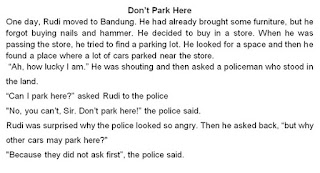- Would you like to come to my graduation party next week?
- I’d very much like to you to attend the meeting next Saturday?
- Would you care to join our journey to Lombok next holiday?
- Come and join my 15th birthday party!
- You must come to the grand opening of my shoe shop.
- That’s very kind of you.
- We’d very much like to come to your graduation party next week.
- What a delightful idea.
- OK!
- Alright.
- Thank you for asking me, but I should go to Bali next week.
- I’d like to. But I have another meeting next Saturday.
- Unfortunately, I can’t. I already have a plan for next holiday.
- Sorry, I can’t.
- I think, I can’t.
- Would you like to ....
- I'd very much like you to ....
- We should be pleased/delighted if you could ....
- Would you care to ....
- That's very kind of you.
- We'd very much like to ....
- What a delightful idea.
- With the greatest pleasure.
- Thank you very much for inviting me.
- I'm very sorry, I don't think I can.
- I'd like to, but ....
- I'm afraid I've already promised ....
- Thank you for asking me, but ....
- Unfortunately, I can't ....
- Why don't you come to ....
- Like to come to ....
- Come and ....
- Shall we come to ....
- You must come to ....
- I would/will ....
- That would be very nice.
- OK!
- I'd like to love to come.
- All right (then).
- Sorry, I can't.
- I'd love to, but ....
- I don't think I can.
- I wish I could, but ....
- Invitation is used to invite someone to come to an event.
- There are two kinds of invitation, those are: formal invitation and informal invitation.
- Formal invitation is used to invite someone who older than us or invite someone in formal event.
- Informal situation is used to invite our friends in informal event.
- There are two kinds of response the invitation:
- Accepting invitation, it we mean that we can attend the invitation.
- Declining invitation, it means that can’t attend the invitation.
Choose the correct answer!
1. You will probably get a formal invitation from ….
a. an old friend
b. a distant relative
c. parents of a friend
d. a neighbor
e. school principal
2. The following does notbelong to the body of a formal invitation: ….
a. greeting
b. date
c. place
d. time
e. agenda
3. "Dear Mr. Manager,"
The part of the invitation is called ….
a. closing
b. body
c. greeting
d. heading
e. signature
4. The followings are the purposes of an invitation, except ….
a. to let people know about the event
b. to ask someone to attend
c. to forbid someone from coming
d. to give detailed information about the event
e. to ensure the participant to come
The text below is for questions no 5, 6 and 7
Quino English Course
12 A Quipper Street, Indonesia
Phone: (+62)222456, e-mail: quino@quipper.com
To all parents of Intermediate Class and Advanced Class student
Dear Sir,
It is our honor to host annual Quino Family Gathering in socializing the new concept of Quino system.
Quino cordially invites all the parents of Quino’s students to participate in the family gathering.
Date : Saturday, the twelfth of June 2015
Time : at nine o’clock to half past twelve o’clock
Place : Hall of Quino English Course, 12 A Quipper Street
Agenda : Socialization*
Dress code: Black tie
The committee extends a warm welcome and is grateful for your involvement.
Yours sincerely,
Muara Indah
Quino President
5. The recipient of the invitation are/is ….
a. students of Quino English Course
b. parents of Quino’s students
c. president of Quino
d. the teachers in the neighborhood
e. Quino committee
6. The invitation is about ….
a. Quino English program
b. Quino’s new system
c. Quino’s students’ performance
d. Family gathering
e. Parents-teachers meeting
7. How long will the family gathering take place?
Choose one of the following ….
a. 2 hours
b. 3 hours
c. a whole day
d. half a day
e. 4 hours
Arrange the following into the correct order
8. The correct arrangement for the part signature of a formal invitation is ….
a. 1-2-3
b. 2-3-1
c. 3-2-1
d. 3-1-2
e. 1-3-2
9. The most appropriate phrase to put in a formal invitation is ….
a. I wonder if you would like to come to my party.
b. Come and join us at the party.
c. Let’s celebrate the New Year eve at Puncak Bogor.
d. Join us for the party.
e. We'd be delighted to have you as our guest at the party.
Complete the following part of an invitation to answer question 10.
It is indeed a pleasure to ... Indonesia 2015 Youth Conference.
We would like to request your honor to participate. This conference ... from 5-7 May 2015. World-known speakers ... key issues for Indonesia Education.
10. Fill the blanks with the most appropriate word.
a. held – will be held – address
b. hosted – will be held – will address
c. host – will held – will address
d. hold – will held – will address
e. host – will be held – will address










Follow Us
Were this world an endless plain, and by sailing eastward we could for ever reach new distances